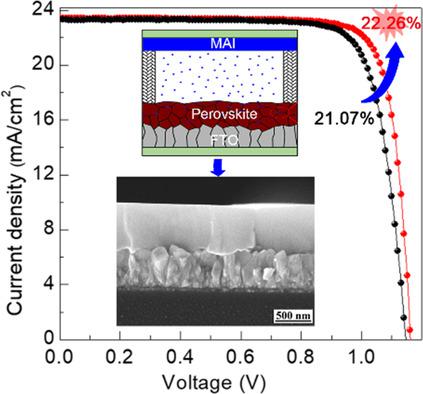Our official English website, www.x-mol.net, welcomes your feedback! (Note: you will need to create a separate account there.)
Anion Exchange‐Induced Crystal Engineering via Hot‐Pressing Sublimation Affording Highly Efficient and Stable Perovskite Solar Cells
Solar RRL ( IF 7.9 ) Pub Date : 2021-01-15 , DOI: 10.1002/solr.202000729 Bin Ding 1 , Jun Peng 2 , Qian-Qian Chu 3 , Shenyou Zhao 2 , Heping Shen 2 , Klaus J. Weber 2 , Guan-Jun Yang 4 , Thomas P. White 2 , Kylie R. Catchpole 2 , Mohammad Khaja Nazeeruddin 1 , Paul J. Dyson 1
Solar RRL ( IF 7.9 ) Pub Date : 2021-01-15 , DOI: 10.1002/solr.202000729 Bin Ding 1 , Jun Peng 2 , Qian-Qian Chu 3 , Shenyou Zhao 2 , Heping Shen 2 , Klaus J. Weber 2 , Guan-Jun Yang 4 , Thomas P. White 2 , Kylie R. Catchpole 2 , Mohammad Khaja Nazeeruddin 1 , Paul J. Dyson 1
Affiliation

|
Crystalline, dense, and uniform perovskite thin films are crucial for achieving high‐power conversion efficiency solar cells. Herein, a universal method of fabricating highly crystalline and large‐grain perovskite films via crystal engineering is demonstrated. Anion exchange of Cl− and I−, and annealing perovskite films, in an ultraconfined and uniform temperature enclosed space with saturated MAI (or FAI) vapor using hot‐pressing sublimation technology are conducted. This process ensures a rapid crystal growth rate due to fast exchange between the gas phase and the crystalline film to reduce vertically oriented grain boundaries. The generation of the commonly observed PbI2 phase is also suppressed due to the chemical equilibrium state during the thermal annealing process. Using this approach, pinhole‐free perovskite films with preferred crystal orientation and micrometer‐scale grains are obtained, leading to a high steady‐state efficiency of 22.15% based on mixed‐cation perovskite composition. In addition, devices based on different perovskite compositions all exhibit enhanced photovoltaic performance based on the crystal engineering method. The device (without encapsulation) has an efficiency loss of about only 4% after 2520 h of aging in ambient conditions and retains 87% of its initial efficiency after 1000 h of continuous 1 Sun light soaking, thus demonstrating considerably improved stability.
中文翻译:

通过热压升华实现高效,稳定的钙钛矿太阳能电池的阴离子交换诱导晶体工程
结晶,致密且均匀的钙钛矿薄膜对于实现高功率转换效率的太阳能电池至关重要。本文展示了一种通过晶体工程制造高结晶度和大晶粒钙钛矿薄膜的通用方法。的Cl阴离子交换-和我- ,和钙钛矿退火膜,在用饱和的MAI(或FAI)的ultraconfined和均匀的温度封闭空间蒸气使用热压热转印技术被进行。由于气相和结晶膜之间的快速交换以减少垂直取向的晶界,因此该过程确保了快速的晶体生长速率。通常观察到的PbI 2的产生由于在热退火过程中的化学平衡状态,也抑制了气相。使用这种方法,可以获得具有最佳晶体取向和微米级晶粒的无针孔钙钛矿薄膜,基于混合阳离子钙钛矿成分,其稳态效率高达22.15%。另外,基于晶体工程方法,基于不同钙钛矿组成的器件都表现出增强的光伏性能。该器件(无封装)在环境条件下老化2520小时后的效率损失仅约4%,并且在连续1个太阳光浸泡1000小时后仍保持其初始效率的87%,因此证明了稳定性得到了显着改善。
更新日期:2021-03-10
中文翻译:

通过热压升华实现高效,稳定的钙钛矿太阳能电池的阴离子交换诱导晶体工程
结晶,致密且均匀的钙钛矿薄膜对于实现高功率转换效率的太阳能电池至关重要。本文展示了一种通过晶体工程制造高结晶度和大晶粒钙钛矿薄膜的通用方法。的Cl阴离子交换-和我- ,和钙钛矿退火膜,在用饱和的MAI(或FAI)的ultraconfined和均匀的温度封闭空间蒸气使用热压热转印技术被进行。由于气相和结晶膜之间的快速交换以减少垂直取向的晶界,因此该过程确保了快速的晶体生长速率。通常观察到的PbI 2的产生由于在热退火过程中的化学平衡状态,也抑制了气相。使用这种方法,可以获得具有最佳晶体取向和微米级晶粒的无针孔钙钛矿薄膜,基于混合阳离子钙钛矿成分,其稳态效率高达22.15%。另外,基于晶体工程方法,基于不同钙钛矿组成的器件都表现出增强的光伏性能。该器件(无封装)在环境条件下老化2520小时后的效率损失仅约4%,并且在连续1个太阳光浸泡1000小时后仍保持其初始效率的87%,因此证明了稳定性得到了显着改善。



























 京公网安备 11010802027423号
京公网安备 11010802027423号